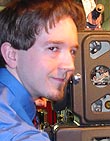|
|
This topic comprises 3 pages: 1 2 3
|
|
Author
|
Topic: Superman Returns Article- What could have been shot in 65mm ends up in HDTV
|
Lyle Romer
Phenomenal Film Handler
Posts: 1400
From: Davie, FL, USA
Registered: May 2002
|
 posted 07-05-2006 07:35 AM
posted 07-05-2006 07:35 AM




One quote of interest:
quote:
“It dawned on me that the reason the 65mm test blew me away was that we were watching it projected in 65mm, and the ability to exhibit this film that way today would be almost non-existent,”
I guess nobody told him they were going to end up releasing in IMAX, not to mention the hundreds of theatres that could have played 70mm.
quote:
http://www.comics2film.com/FanFrame.php?f_id=20718
HD Heroes
Jun 1, 2006 12:03 PM, By Michael Goldman
Striving for a Unique Filmic Look with Genesis
When, at press time, Superman Returns rolled into the digital intermediate phase at Technicolor Digital Intermediates (TDI), Burbank, Calif., it was very close to a complete movie, awaiting only the completion of a handful of visual effects shots. As that was happening, director Bryan Singer paused to express great satisfaction with his workflow and the resulting content. Singer gives part of the credit for these results to the choice he and his cinematographer, Newton Thomas Sigel, ASC, made to deploy the Panavision Genesis digital camera system for the film's image acquisition needs.
Ironically, given his early commitment to the then-unproven Genesis system, Singer insists he's “a regular, old-fashioned guy” who very much wanted a filmic ambiance weaved into his tribute to the legacy of the big lug in the blue tights. In fact, he didn't jump into the HD pool quickly, or easily.
“We cut The Usual Suspects [1995] on film, don't forget,” he says. “It took me a while to convert to the Avid, let alone shoot a big, romantic movie, which Superman Returns is, with digital cameras. I'm kind of surprised we went this way, to be honest, but we did. I talked to all the guys [shooting with digital cameras] — George Lucas, Michael Mann, Jim Cameron, who is a friend of mine. I was at Lucas' ranch with all those other filmmakers a few years ago when he had his digital summit to educate everybody about HD. That was before I made [X-Men 2], and I was hardly a convert at that point. I wasn't ready. But I got to talk to a lot of filmmakers about this process, and I became more open-minded by the time I took over this project.”
Why Genesis?
When deciding on the recording medium for Superman Returns, director Bryan Singer and DP Newton Thomas Sigel, ASC, shot tests with Super 35 and 65mm, the latter of which impressed them visually, but not in terms of cost and convenience. They opted to use the Panavision Genesis digital camera system in an attempt to replicate the visceral feel and rich color of 65mm, as illustrated in some of these shots, but with the production advantages of HD.
Photos by David James. ©2006 Warner Bros. Entertainment Inc.—U.S., Canada, Bahamas, and Bermuda. All Rights Reserved.
Still, it was Singer's desire to experiment with different kinds of rich, filmic looks during his early tests, combined with Sigel's intense research into Genesis, that was most responsible for moving Superman Returns into the digital acquisition column. Singer says he had “a brief, crazy notion” to shoot the movie on 65mm film, and that eventually led him and Sigel into the Genesis universe.
“We shot a test with [lead actor] Brandon Routh, purely for the sake of experimentation, on 65mm, using an old camera that Tom Sigel had access to — just a few takes,” Singer recalls. “We shot the screen test in Super 35 and 65mm, and when we printed and compared them, we both realized the large-format material was so vivid and had so much resolution. At that point, I actually started thinking about shooting the movie that way, but, of course, the cons outweighed the pros. No one in Australia, where we were going to shoot the movie, processes 65mm; the cameras are way too heavy; the film stock is very expensive. It was just way too cumbersome of a technology for a movie like this.
“But Tom Sigel mentioned he had heard about this new camera that Sony and Panavision had developed together from the ground up. He told me that if we used it, we could use the same [Super 35] lenses we were familiar with, with Panavision-accessible equipment, and that he thought that maybe, because they were laying the image off onto a single chip, that the image, in terms of color and dynamic range, might be close to the richness we were looking for.”
According to Singer and Sigel, filmmakers did a wide range of tests in Australia, comparing Genesis to Super 35. “We filmed it all out, locked ourselves in a screening room in Sydney, watched every bit of it, and made a decision between the two of us to go with the Genesis camera,” Singer says.
Sigel adds that, based on dailies, preview versions of the movie, and several filmout tests ahead of the DI, the production's initial commitment to the format paid off, in his opinion. He says, “[The format achieved the] smoothness and creaminess that 65mm had, while still giving us something new and different.”
“It dawned on me that the reason the 65mm test blew me away was that we were watching it projected in 65mm, and the ability to exhibit this film that way today would be almost non-existent,” Sigel says. “Then, I recalled how impressed I was with the Genesis tests I had seen at Panavision. It also meant I could use the same film lenses [Primo zooms and primes] I always use. Not just similar lenses, but the actual lenses I have been using for 10 years, which are kept available for me at Panavision. We tested the camera backward and forward, and I had never seen HD that way. I was intrigued by the idea that we could have a tonal and dynamic range close to film, and yet, give it a new, fresh look at the same time. We thought Genesis had better range than the [Sony HDW-F950 cameras], it didn't have to be tethered like the [Thomson Viper FilmStream] cameras, and it was further along in development than some others, like the Dalsa [Origin] and [Arriflex D-20] cameras. During production, we were able to throw the camera around, put it on a Steadicam, fly it from cables, and all kinds of other applications. Although it was early in the camera's life, I'm happy to say, it actually worked out the way we planned it. We got the resolution, detail, and the elegant look we wanted.”
And it was indeed early in the camera's life when the project launched — so early that Superman Returns actually accelerated the system's ongoing evolution. When the project began, for instance, the production did not yet have access to the software necessary to record images at speeds higher than 24fps. Therefore, they initially began shooting miniatures using film cameras. The ability to shoot 30fps and, later, 50fps soon came along, however, and Sigel decided Genesis could work fine on a motion control rig. He therefore switched to using Genesis for miniatures, except for a couple of instances when ultra-high-speed photography was required.
“As Genesis evolved, we worked with Sony and Panavision to add all sorts of things we needed — cables, power ports, Hollywood handles, and other amendments to their original design, which I'm sure will probably be used in future films by other filmmakers,” Singer adds.
The Palette
On set, filmmakers relied on 24in. Sony HD monitor (pictured: Singer with actor Kevin Spacey) while shooting.
Photo by David James. ©2006 Warner Bros. Entertainment Inc.—U.S., Canada, Bahamas, and Bermuda. All Rights Reserved.
The basic workflow during production involved recording to a Sony SRW1 VTR, usually docked onboard the Genesis camera on location in Australia. Original camera tapes were taken to post facility Cutting Edge in Sydney, where clones were made for archival and security purposes, and where sound was synched to picture. Dailies tapes in the HDCAM-SR format were then made and color corrected by colorist Trish Cahill at Cutting Edge, before being sent back to the production and digitized for editing.
This method was part of Sigel's overall plan to create much of the color palette in postproduction, based on specific parameters. Thus, Cahill's color timing work on dailies was based on a specific look designed in preproduction by Sigel, working with Stephen Nakamura, senior colorist at TDI, who would later handle the final color grading process during the DI. Filmmakers, in fact, took the unusual step of bringing Nakamura to the set in Australia, and then to Cutting Edge to work with Cahill to establish the general palette, while retaining flexibility for specific changes and details to be added later during the DI. Sigel also provided reference stills to Cahill each day that he personally color corrected in Photoshop to give her a template for specific shots.
“This was the first time I had worked this way, in terms of going to the location and working with the dailies colorist extensively early on,” explains Nakamura. “The idea was to make sure we were all on the same page, since this movie has a specific look. Tom Sigel was very concerned that everyone get used to the look during dailies, so that by the time they got to the DI, people would not be surprised that it looked different from what they had become accustomed to with dailies. So we designed the look and applied it during dailies, and by the time we got to the DI, we had basically pre-timed the whole thing. That is unusual in the sense that we don't normally do a lot of secondary color correction and defocus and things for dailies. But it paid off, because Tom Sigel knew he would be applying a certain portion of the look in post, and we needed to build that into the dailies for everyone to understand what he was going for.”
Singer manipulates models on a rooftop for the film’s bank-heist scene—a sequence shot with the Genesis camera operating on a Scorpio remote head.
Photo by David James. ©2006 Warner Bros. Entertainment Inc.—U.S., Canada, Bahamas, and Bermuda. All Rights Reserved.
Sigel adds that this whole issue of pushing Genesis-acquired imagery toward the digital intermediate, while keeping a clear and consistent vision of how the images would look on film along the way, was the subject of great concern from the project's earliest days.
“One of the main things I tested when looking at the Genesis camera was to see, when I got to the DI, would I lose the flexibility that I always had with an original film negative?” Sigel says. “What I found is that I had the same range of manipulation available to me as if I had shot on film. That gave me a lot of confidence that I would not have to sacrifice in the DI by originating on Genesis.
“Having said that, there is still a big difference in the DI when you originate digitally with this kind of system, and that difference is, simply, that what you see in the DI environment and what you see on the final filmout is not the same, exact thing. When you do a DI from something originated in film, we have created a series of LUTs so that, even though you are projecting data while doing color correction, you are projecting it in film space, and the original material already has the inherent qualities of film and grain built into it. When you do a DI from material that originated digitally, you start with an image that has no grain and none of the softening characteristics of film. No matter how many LUTs you have, there will always be a difference between what you see when you digitally project an image acquired on film and when you digitally project an image acquired digitally. The digital image, in other words, will always pick up some grain and softness along the way, because, for exhibition in [almost all] theaters, you are still outputting back to film. That will always be an additional process you go through, to add grain and softness, before outputting to film. That's why, during testing, we were constantly going back to film to see what it would look like.”
Performance
Singer’s crew shoots a key scene using the Genesis camera system with a Scorpio head on a Super TechnoCrane.
Photo by David James. ©2006 Warner Bros. Entertainment Inc.—U.S., Canada, Bahamas, and Bermuda. All Rights Reserved.
On set, Sigel monitored imagery from a control station consisting of a 24in. Sony HD monitor, a waveform monitor, and a computer for recording digital stills and lighting information. He concedes this monitoring approach involved a cultural change for him as both the DP and an operator on the project.
“I've operated ‘A’ camera on every movie I've ever done, and in that sense, I was disappointed that we did not have an optical viewfinder on the one hand,” he says. “But what I found was that the 24in. monitor was a better viewfinder than any film camera I've ever seen. When you shoot with an optical viewfinder, you look at something off a mirror, and just get part of the light through a flickering shutter. We have all grown used to that over the years, and we do a good job with it. But if you compare that to a crystal-sharp, 24in. HD monitor, there is no comparison. You see focus, shadow detail, and other things on the monitor that you would never see in a viewfinder. So, in that sense, it's sort of a tradeoff. If you are not operating, it's superior, but if you are operating, then yes, it is a conundrum. On the one hand, you get a better image when you look at the monitor, but on the other hand, you are not getting that image while operating the camera, unless you are working off a remote head.
“But we did use remote heads a lot, and I must say, the camera held up great. We did a flycam, Steadicam, lots of crane stuff. It's a little heavy for Steadicam, but we were able to do it, and for everything else, it was pretty much used like a film camera. For this movie specifically, I did not find any situations where there was something I wanted to do that I couldn't do.”
Sigel says Genesis performed exceptionally well, as anticipated, in low-light situations, but adds that he eventually learned to bend the camera to his needs, rather than trying to tailor the imagery to Genesis' perceived strengths.
As Genesis evolved, Singer (pictured, right), Sigel, and the crew added cables, power ports, Hollywood handles, and other tools to the system—a setup Sigel asserts will be used for future projects.
Photo by David James. ©2006 Warner Bros. Entertainment Inc.—U.S., Canada, Bahamas, and Bermuda. All Rights Reserved.
“We shot a lot of day exteriors and had no problems,” he reports. “Everyone talks about how the camera sees into the shadows better, and that is generally true, and you are basically better off underexposing rather than over-exposing like you would with film negative. But having said that, my first few days, I was overly courageous and started going with so little light that, later, when I wanted to play with the image, manipulate it, I had boxed myself into a corner. So you have to be careful not to get swept away about shooting with limited light. You can run into lots of the same problems that you run into when you underexpose a negative and do a DI, saying you want to see more of this or that, and then, when you try to bring it up, you get a lot of video noise.”
Sigel was also extremely satisfied with the camera's performance shooting effects plates. But, he points out, the process of crafting LUTs for vendors, while similar to film-world procedures, is a road less traveled, and therefore somewhat more complicated when it comes to brand-new digital cameras.
“Creating LUTs, all that kind of stuff, is not that different from what we would do for vendors if we shot film, but the difference is that work has already been done in the film world,” he explains. “If you tell the vendor what stock you are using and give them other details, they know it already — it's in their system. With HD, there is more data management; it isn't all well established. But procedurally, it's not that different than what you would expect with any major effects film.”
Entering the DI phase at press time, Sigel said filmmakers were on track for “creating color space in post.” Following the edit, the movie was conformed and data-managed at Digital Sandbox, Los Angeles, before beginning the color timing phase at TDI.
Sigel (pictured) prepares two Genesis systems, set to record to Sony SRW1 VTRs, on the Daily Planet set.
“The Genesis gave us sort of a creamy kind of illustrative quality, which is what we designed, but the finishing touch is all being done in the DI, based on the look we created earlier,” Sigel says. “It's a subtle balance.”
Singer specifies that this basic approach to the DI is somewhat different, from a philosophical point of view, from the typical color-grading methodology on movies shot digitally.
“It's not really a digital intermediate in the sense that we shoot digitally — it's more like a delivery element, I guess you would say,” Singer explains. “It's different than, say, what George Lucas would do on a Star Wars film. He shoots digitally, drops in all visual effects, and then grades everything as a whole. We, on the other hand, are grading each image — the equivalent of color timing each image separately, the way you would in a conventional timing session with film, except using technology that permits us to work on digital files. Then, we are putting the effects in and doing a complete re-grade. It's a little more complex than the way others have done it for these kinds of films, and we are sort of working it out as we go along.”
Nakamura adds that with the basic color scheme pre-built on the front end, his job during the DI largely revolves around customizing imagery using his Da Vinci 2K system's ability to change gamma curves, highlight key defocus, and layer on secondary color corrections. As with most projects, his ultimate success with tweaking the imagery to Singer's specifications, he emphasizes, was largely dependent on the quality of Sigel's photography.
But, he adds, the project's use of the Genesis camera did make parts of his job easier.
“For one thing, I don't have to run much noise reduction with this material, because it was so clean,” says Nakamura. “And when we went to go out to film, the film grain is there, but I don't have to run as much noise reduction as I do when they shoot film. Also there is obviously no dirt fixing or scratch removal. The images are just so clean. So avoiding most of that stuff, I can get right to creative issues, and since the photography was so excellent, we're able to give filmmakers the results they are looking for.”
Sigel says the Genesis, as expected, performed well in low-light situations, such as this exterior shot in Australia at sunset. He warns, however, that in post, the darker shots caused the same problems as trying to work with an underexposed film negative.
Photo by David James. ©2006 Warner Bros. Entertainment Inc.—U.S., Canada, Bahamas, and Bermuda. All Rights Reserved.
That end result, Singer and Sigel are confident, will be a painterly, filmic look that evokes the era that gave birth to Superman comics in the 1930s. But Sigel insists he would prefer to see any richness achieved on his digital negative left out of the ongoing digital-versus-film debate, because it's all beside the point.
“Yes, we got that certain filmic quality in the sense of having the tremendous range of tonality and contrast and color we wanted. And yet, I would like to think that, little by little, through baby steps, we might actually move beyond the question of, ‘Does it look like film?’” Sigel says. “I think we are heading toward something more like an evolution of the look of film — something that has elements of film that we still find beautiful and appealing, and yet, has a new quality to it, as well.
“And that's no different than what Kodak and others have been doing with their film stocks anyway — they are evolving them. So, what ‘looks’ like film anyway? I mean, films from 100 years ago were, in fact, shot on film and have a ‘filmic’ quality, but they don't resemble movies shot today on film, or movies shot on HD. So there is no reason to think that with HD capture, not to mention the arrival of the digital intermediate, that we can't produce movies with a filmic sensibility, but which at the same time, continue that evolution of the look of motion pictures generally.”
| IP: Logged
|
|
|
|
|
|
John Walsh
Film God

Posts: 2490
From: Connecticut, USA, Earth, Milky Way
Registered: Oct 1999
|
 posted 07-05-2006 11:47 AM
posted 07-05-2006 11:47 AM




The article only mentions 65mm production costs. After that, there's the additional costs to strike 70mm prints. And, sorry to say, a few will be ruined within the first few days of release.
That said, my own feeling is that regardless of the additional cost of 65/70mm production and prints, it represents a very small cost of the overall buget. Undeveloped negatives can be flown to where it can be processed, since the shots are checked by video; cameras are on tripods and Panavision made a new line of lighter 65mm cameras only about 10 years ago; and negative costs are just not *that* expensive. Lastly, 35mm blow-ups to 70mm release still look great, and have no effect on location production.
If the some of the actors and higher-level producers slept in regular good hotels instead of $5000 a night palaces, ate regular good food instead of flying in a fancy chef and dropped some of the other outrageous perks, the difference would easily pay for 65/70mm production.
| IP: Logged
|
|
|
|
|
|
|
|
|
|
Dave Williams
Wet nipple scene

Posts: 1836
From: Salt Lake City, UT, USA
Registered: Jan 2000
|
 posted 07-05-2006 02:36 PM
posted 07-05-2006 02:36 PM





You have to take into account that the general public doesn't care about 65mm or digital or whatever. They care about seeing a quality image projected that they can see, and sound they can feel. With so many houses woefully lacking in quality projection, most movie makers are willing to accomidate the new digital medium, both in production and in the back end of projection. It solves the problems of quality in most cases.
It also makes things easier on movie makers. With equipment becoming less cumbersome, it becomes less taskful in planning shots and scenes. It becomes much easier to shoot on location instead of using large soundstages. It creates an entirely new realm of movie making that has previously been too difficult and therefore too costly.
I welcome the digital realm. I only see my films digitally now. I am tired of projectionists that cannot focus to save their lives. By embracing the new technology, we help it along during its evolution.
Just remember that movie makers must please the general public, so concerns from a very small minority will never be taken into any consideration.
As for budget, when I start to spend too much money, and I need to curtail it, I don't look at something and say "hey, it's not much more than you have already spent, go ahead and get the plasma screen", I actually have to take into account if spending even more money is really worth it. I know you can make lots of arguments about shooting on large format film, but lets face it, there has to be limits to how much money is enough to spend on it.
Ciao
| IP: Logged
|
|
|
|
|
|
|
|
Mark Ogden
Jedi Master Film Handler
Posts: 943
From: Little Falls, N.J.
Registered: Jun 99
|
 posted 07-05-2006 05:16 PM
posted 07-05-2006 05:16 PM




quote: Joe Redifer
I am curious why they would choose the more difficult HDTV over the easier Hi8
Or even better! Why not just dump videotape altogether and make an entire movie using Canon EOS digital still picture cameras slaved to laptops, just like Tim Burton did for The Corpse Bride?
Or, yeah, like Joe says, why not use just little POS handheld consumer video cameras to make a movie, just like the crews of 24 Hours Later, Full Frontal, The Anniversary Party, Dancer in the Dark, Robot Stories, Chuck & Buck, The Buena Vista Social Club, Pieces of April, Tadpole, Bamboozled, The Blair Witch Project, The Ballad of Ramblin' Jack, Gengis Blues and on and on . . .
Why not make it easy on yourself and your budget?
| IP: Logged
|
|
|
|
Mike Schindler
Phenomenal Film Handler

Posts: 1039
From: Oak Park, IL, USA
Registered: Jun 2002
|
 posted 07-05-2006 08:32 PM
posted 07-05-2006 08:32 PM




quote: Brian Michael Weidemann
I think you've just been going to a theatre with a horribly dirty booth, and have been unnecessarily jaded toward the medium.
I thought that this was the case, which is why I went to SUPERMAN RETURNS at a different theater than I had in the past. Unfortunately, the problem was worse. I'm sure that you're right, but the fact of the matter is that the theaters I can get to have this problem. Also, for some reason I can't figure out, the sound sucks in these two theaters.
As for the other thing, there's a difference between something being hard and something being just not practical. I'm willing to bet that many shots in SUPERMAN RETURNS would not have been possible with a 65mm camera. Then it becomes a question aesthetics, and whether or not the added resolution is worth compromising other aspects of the movie. I'm not saying that it's not. I'm just saying that there's a lot to consider.
| IP: Logged
|
|
|
|
All times are Central (GMT -6:00)
|
This topic comprises 3 pages: 1 2 3
|
Powered by Infopop Corporation
UBB.classicTM
6.3.1.2
The Film-Tech Forums are designed for various members related to the cinema industry to express their opinions, viewpoints and testimonials on various products, services and events based upon speculation, personal knowledge and factual information through use, therefore all views represented here allow no liability upon the publishers of this web site and the owners of said views assume no liability for any ill will resulting from these postings. The posts made here are for educational as well as entertainment purposes and as such anyone viewing this portion of the website must accept these views as statements of the author of that opinion
and agrees to release the authors from any and all liability.
|

 Home
Home
 Products
Products
 Store
Store
 Forum
Forum
 Warehouse
Warehouse
 Contact Us
Contact Us




 Printer-friendly view of this topic
Printer-friendly view of this topic








![[Roll Eyes]](rolleyes.gif)

![[Razz]](tongue.gif)




![[thumbsup]](graemlins/thumbsup.gif)



